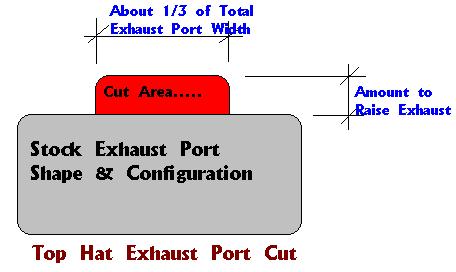|
"Engine
Blueprinting"
using
The Engine Analysis Program
Part 2
Exhaust Port Shape & Timing:
After you have set the intake timing to figures
which are within the range we talked about last month, it now
time to start on the Exhaust port. It is here that you will determine,
to a large extent, the RPM range that your engine will run within.
What do I mean by this? It is VERY IMPORTANT at this stage to
think about how you will use your power plant. Are you setting
up an engine to power a heavy model? Is you racing model VERY
LIGHT? These are primary questions you MUST answer at this point.
If the model is very heavy, you will want to preserve power in
the LOWER RPM RANGES. If this is the case, the exhaust timing
should stay near the stock configuration. If you don't raise
the exhaust port and thus the duration of it's open time remains
relatively short, the engine will operate VERY well with a heavy
model in the lower RPM ranges. A good example of this is for
most 1/8 scale hydros. These boats range in weight from a very
light 1/8 scale boat of 10 lbs to a heavy 1/8 scale boat of 18lbs
and over. Most 1/8 scale boats are somewhere in between. What
then is the IDEAL exhaust duration for the heavy model. I would
say that you should look at 175 to 178 degrees. If your model
is very light you should look at exhaust open durations of 180
to 190 degrees. The higher the exhaust timing (more the duration
of open time) the higher you shift the RPM band. I could talk
about the relationship between the engine timing, the prop, the
pipe, the fuel, etc at this point, but first lets get the engine
"blueprinted" and as optimized as possible. What is
the best shape for the exhaust port? How do I cut the exhaust
port higher, thus increasing the open time of the exhaust port?
I can tell you what has worked for me, and you can probably get
as many DIFFERENT answers to this question as you want. So I
will share what has worked for me. After reading as many different
books as I could get my hands on, I early on figured that we must
make it easy for the piston to stay in the liner. What do I mean?
The LARGER the exhaust port, the more the piston tries to climb
out the port! If you make the cut along the top of the port full
width, it gives the piston an easier chance to climb out the port
and ruin the piston. I cut only a notch approximately 1/3 the width of the port so as to minimize this characteristic. I believe
that it also preserves a larger part of the low end power of the
engine, by only cutting 1/3 of the width. The following sketch
shows how I do this.

Using The Engine Analysis Software, it is easy
to determine the amount to raise the exhaust port as illustrated
above. You have at this point decided the duration that you want,
based on the weight of the model, and now using The Engine Analysis
Software you can measure from the top of the liner to the top
of the exhaust port to get EXACTLY the timing you want. Note:
Be sure to deburr around the areas of the port where you have
cut. I use a small round stone to break the edge and deburr the
port. What is the best way to cut the raised port?
If you have access to a milling machine, use a carbide cutter
spinning as fast as the mill will run. If you don't have access
to a milling machine, use a Dremel Tool with a carbide cutter.
I can't tell you how many engines I have done with nothing more
than a Dremel Tool! BE VERY PATIENT AND ACCURATE! You can scribe
a line where you want the top of the exhaust port to be using a set of Vernier Calipers.
They will scratch a very fine
line at the point indicated by The Engine Analysis Software.
Here are some inexpensive digital calipers available from MSC which I found recently. Also shown is a depth micrometer,
which is very helpful for measuring the depth from top of liner to top of piston.

Another FINE source for any serious
2 cycle engine builder is a book authored by Dr. Gordon Blair,
a researcher and one of the foremost 2 cycle experts in the world.
This is the ultimate technical guide available.
The Blair book & software can be purchased from SAE (Click Here)
|